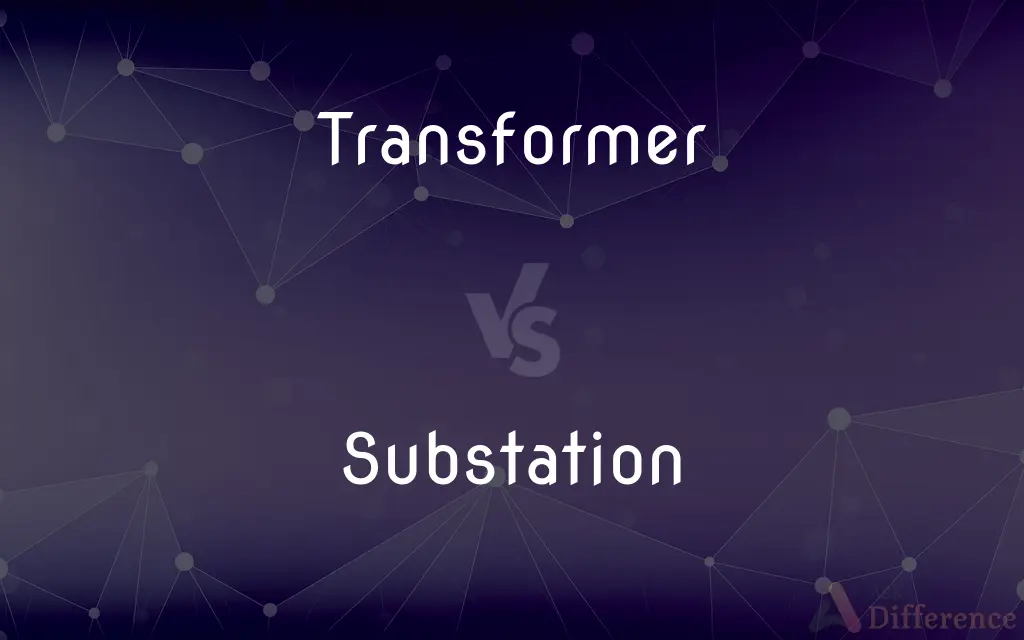Transformer vs. Substation — What's the Difference?
By Maham Liaqat & Fiza Rafique — Updated on March 9, 2024
A transformer is a device that changes the voltage of electricity, essential for efficient power distribution, whereas a substation houses transformers and regulates power flow in the grid.

Difference Between Transformer and Substation
Table of Contents
ADVERTISEMENT
Key Differences
A transformer plays a crucial role in the electrical power distribution system by either stepping up or stepping down the voltage levels to meet the requirements of the end-use. It ensures that electricity is transmitted efficiently over long distances, minimizing losses. On the other hand, a substation is a key component of the electrical generation, transmission, and distribution system. It not only houses transformers but also includes switches, circuit breakers, and other equipment necessary for controlling the flow of electricity and protecting the system from faults.
Transformers operate on the principle of electromagnetic induction to modify voltage levels, which is critical for reducing energy loss during transmission. By increasing the voltage for transmission and decreasing it for distribution, they make the electricity grid more efficient and cost-effective. Substations, whereas, serve as nodal points in the power grid where the voltage is transformed and the direction of power flow is managed. They are strategically located to optimize the reliability and performance of the electricity supply network.
The design of a transformer is focused on its core and windings, with its efficiency largely dependent on the core material and the electrical characteristics of its coils. This design is optimized to achieve minimal energy loss and heat generation during operation. Conversely, the design of a substation is more complex, encompassing a wide range of electrical components and systems designed to monitor, control, and protect the electricity transmission and distribution network. It requires careful planning to ensure safety, reliability, and efficiency.
Maintenance of transformers primarily involves monitoring their operating temperature, insulation quality, and electrical parameters to prevent overheating and degradation. This ensures their long-term reliability and efficiency. Substations require more comprehensive maintenance strategies, including the inspection and testing of protective relays, circuit breakers, and other equipment to ensure the safety and continuity of power supply across the grid.
Transformers can be found in various settings, from industrial sites and commercial buildings to residential areas, ensuring that electricity is delivered at usable voltages. Substations, however, are strategically placed within the power grid to effectively manage and distribute electricity from power plants to consumers, often located in accessible yet secure areas to facilitate maintenance and minimize the impact on the surrounding environment.
ADVERTISEMENT
Comparison Chart
Function
Changes voltage of electricity
Houses transformers and regulates power flow
Operating Principle
Electromagnetic induction
Electrical control and distribution
Key Components
Core, windings
Transformers, switches, circuit breakers
Design Focus
Efficiency and minimal energy loss
Safety, reliability, control of power flow
Maintenance
Temperature and insulation monitoring
Comprehensive equipment inspection and testing
Location
Industrial, commercial, residential areas
Strategic points in the power grid
Role in Power System
Efficient power transmission and distribution
Nodal point for voltage transformation and control
Compare with Definitions
Transformer
Varies in size from small units in electronics to large installations in power grids.
The large transformers at the power station can be quite imposing.
Substation
Houses transformers and other critical equipment.
The substation near the river is crucial for the city’s power distribution.
Transformer
Requires regular maintenance for optimal performance.
The maintenance team checked the transformer for any signs of wear and tear.
Substation
Requires strategic placement for optimal grid performance.
Planners determined the ideal location for the substation to maximize coverage.
Transformer
Utilizes electromagnetic induction to adjust voltage levels.
Engineers designed a transformer to efficiently reduce the transmission voltage.
Substation
Involves complex designs for safety and efficiency.
The substation’s design incorporates the latest in electrical safety features.
Transformer
A device for changing the voltage of alternating current.
The transformer outside our house steps down the high voltage for home use.
Substation
A facility in the electrical system for switching, controlling, and regulating power flow.
The new substation will improve the reliability of our electricity supply.
Transformer
Critical for long-distance electricity transmission.
Without transformers, we couldn’t transmit power efficiently over long distances.
Substation
Plays a key role in both transmission and distribution networks.
Upgrading substations can significantly enhance grid efficiency.
Transformer
A transformer is a passive component that transfers electrical energy from one electrical circuit to another circuit, or multiple circuits. A varying current in any one coil of the transformer produces a varying magnetic flux in the transformer's core, which induces a varying electromotive force across any other coils wound around the same core.
Substation
A subsidiary or branch station, as of a post office or an electric utility.
Transformer
One that transforms:a transformer of recruits into soldiers.
Substation
A site where electricity supplied by long-distance (high-voltage) transmission lines is transformed and/or regulated for local (low-voltage) distribution.
Transformer
A device used to transfer electric energy from one circuit to another, especially a pair of multiply wound, inductively coupled wire coils that effect such a transfer with a change in voltage, current, phase, or other electric characteristic.
Substation
A satellite police station serving one neighborhood or part of a larger jurisdiction.
Transformer
Something that transforms, changing its own or another thing's shape.
Substation
A subsidiary station where electricity is transformed for distribution by a low-voltage network
Transformer
(electrical engineering) A static device that transfers electric energy from one circuit to another by magnetic coupling. Their main use is to transfer energy between different voltage levels, which allows choosing most appropriate voltage for power generation, transmission and distribution separately.
Transformer
(machine learning) A neural network architecture that relies on self-attention mechanisms.
Transformer
Alternative case form of Transformer
Transformer
One who, or that which, transforms. Specif. (Elec.), an apparatus for producing from a given electrical current another current of different voltage.
Transformer
A toy consisting of a figure or representation of an object, constructed of interlocking parts in such a way that a series of turning or twisting motions of the parts can transform the object from one type of object to a different type of object, such as from an animal to an automobile.
Transformer
An electrical device by which alternating current of one voltage is changed to another voltage
Common Curiosities
What equipment is typically found in a substation?
Transformers, switches, circuit breakers, and control equipment.
What is the primary function of a transformer?
To change the voltage of electricity for efficient transmission and distribution.
How do transformers reduce energy loss?
By stepping up voltage for long-distance transmission and stepping it down for local distribution, minimizing resistance losses.
Can transformers be used in both transmission and distribution?
Yes, transformers are used at various stages in the power system for both transmission and distribution.
What maintenance does a transformer require?
Monitoring temperature, insulation quality, and electrical parameters to prevent failures.
How does a transformer work?
It uses electromagnetic induction to convert voltages without changing the frequency.
What types of substations exist?
There are transmission substations, distribution substations, and switching substations, among others.
Why are substations important in the power grid?
They regulate the flow of electricity, ensuring reliable and efficient distribution to consumers.
How do substations contribute to grid safety?
By housing equipment that protects the grid from faults and ensures safe power distribution.
Are substations only used in large power grids?
No, substations are used in all sizes of power grids, from large to small, to manage power flow.
How does the design of a substation affect its efficiency?
Efficient design includes optimal layout of components, effective cooling systems, and integration of modern control technology.
What is the difference between a transformer and a converter?
A transformer changes the voltage of alternating current (AC), while a converter changes AC to direct current (DC) or vice versa.
Can a transformer fail?
Yes, transformers can fail due to overheating, insulation breakdown, or other electrical faults.
Do transformers generate electricity?
No, transformers do not generate electricity; they only change the voltage of existing electrical power.
How are substations protected from environmental impacts?
Through careful design, location selection, and sometimes physical barriers to minimize exposure to natural elements and vandalism.
Share Your Discovery

Previous Comparison
Quarterfinal vs. Semifinal
Next Comparison
Strategy vs. ApproachAuthor Spotlight
Written by
Maham LiaqatCo-written by
Fiza RafiqueFiza Rafique is a skilled content writer at AskDifference.com, where she meticulously refines and enhances written pieces. Drawing from her vast editorial expertise, Fiza ensures clarity, accuracy, and precision in every article. Passionate about language, she continually seeks to elevate the quality of content for readers worldwide.
















































